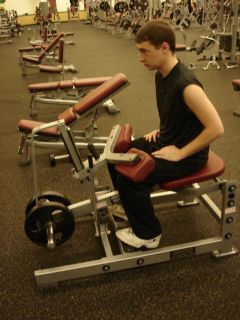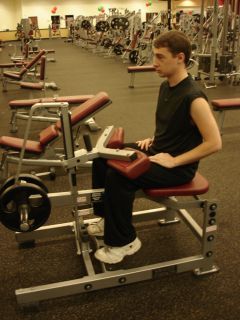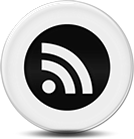Seated Calf Raises
Seated calf raises -- exercise to develop the muscles at the back of the lower leg
Seated calf raises develop the two muscles at the back of the lower leg -- the soleus and gastrocnemius muscles.
The soleus muscle is the deeper muscle. It lies under the gastrocnemius. The gastrocnemius is the muscle that give shape to the calf.
Start by sitting with the legs bent at 90 degrees

Seated calf raises -- starting position
The weight should rest comfortably on the top of the thighs. The front of the feet should be firmly on the platform.
If the feet are to far back it is difficult to support the weight. If the feet are too far forward you will have limited movement at the ankle.
Contract the calf muscles and raise the weight

Seated calf raises -- second position
As you contract the calf muscles the feet extend at the ankle joint.
You want to make sure you get a good range of motion. Extend the feet as far as possible. Then when you return to the starting position let the feet flex upward and get a good stretch of the calf muscles.
Development of the calves
The calf muscles get a lot of exercise. They are working all day long while you are walking, running and standing. Because of this they are remarkably strong.
Despite this everyone wants stronger calves. Women like the way the calf muscles give shape to the lower legs. That's why they wear high heels. Men without strong, developed calves look weak and unbalanced.
How the calf muscles work
The soleus and the gastrocnemius muscles both form the Achilles tendon, the very thick, strong tendon that attaches the leg muscles to the heel.
When these muscles contract they work together to pull on the heel and cause the foot to extend.
Then why two muscles?
So why two separate muscles instead of one? It's because the soleus attaches to the lower leg, but the gastrocnemius attaches to the lower part of the femur in the thigh. So the gastrocnemius also helps to flex the knee.
In the seat calf raise, with the knee flexed, the tension is taken off the attachment of the gastrocnemius to the femur.
So this exercise brings the soleus into action more than exercises that have the knee extended. That gives you fuller development of the calves.
Popular articles:
With weight loss, knowledge is power...
If you know these few truths on this page -- and if you apply them consistently in your life...
If you can't stay on it forever and be fit and healthy and strong -- then it's an extreme diet.
Here's the easy way to ruin any slightest chance you have of losing weight...
Can you eat in restaurants and still respect yourself in the morning?
Calorie density is the difference between vegetable soup and a bagel.
Hidden calories that ruin your waistline...
Will it really help to drink water to lose weight?


